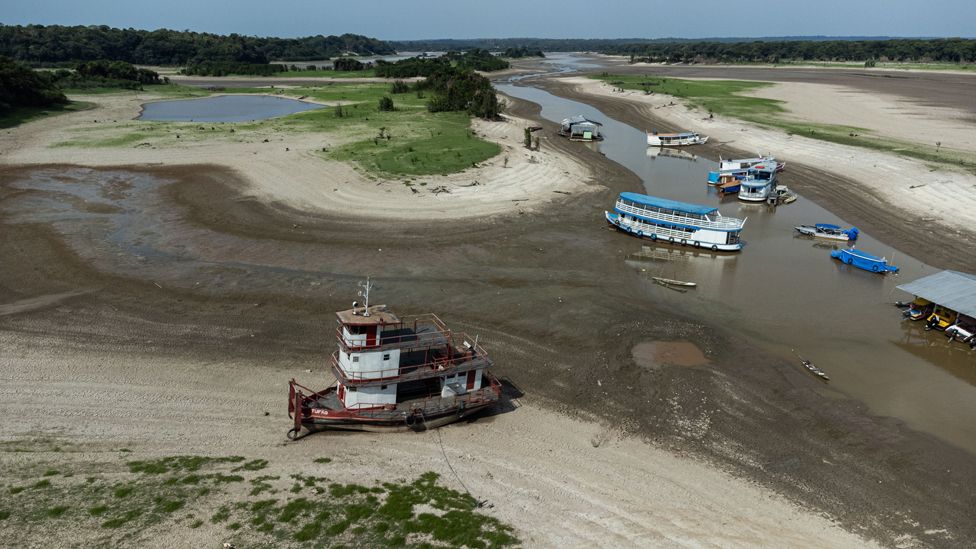
2023-11-14 02:30 PM
Amazon drought leads to lowest Rio Negro levels in 120 years
Amazon drought sparks fears of climate tipping points
Source: Financial Times, November 2023
One of the world’s largest rivers and a major tributary of
the Amazon, the yawning Rio Negro is a pillar of the rainforest ecosystem that
is crucial to the stability of the global climate. But vast sections of the
waterway are currently dry.
For weeks, an unprecedented drought has pummelled the
region, reducing water levels in key Amazonian arteries to record lows and
wreaking havoc on local communities and the unique wildlife of the biome.
The immediate victims of the drought are more than half a
million people in Brazil’s Amazonas state, who are suffering an unfolding
humanitarian emergency as the region’s river-borne transportation is choked by
the lack of water.
But the drought also has far-reaching implications for the
Earth’s climate. As the extreme heat and water shortage kills trees and sparks
fires, the forest begins to release its enormous stocks of carbon dioxide,
fuelling the process of global warming that scientists say was an important
factor behind the drought in the first place.
“It is starting a vicious circle that will destroy forest,”
said Philip Fearnside, a scientist at the National Institute for Amazonian
Research in Manaus.
“Because of this huge stock of carbon in the forest, the
Amazon is at the centre of this question of global warming escaping from human
control. If just a fraction comes out, it would be the straw that breaks the
camel’s back. And there is an increasing risk of that happening.”
In Manaus, a port city in the heart of the rainforest, the
watermark of the river has fallen as low as 12.7m — more than 6m below the
historic average for October — leaving the docks barren as the region’s rivers
lose much of their transport function.
More than 60 municipalities in Amazonas, the state that
includes Manaus, are officially in a state of emergency, with the government
rushing in basic supplies including food, water and medicines.
“Rivers are our roads, so it has become impossible to go
anywhere,” said Fredson Farias, who sells boat tickets at Manaus port. He
estimated that footfall had dropped by 70 per cent.
“There are parts of the river that are 95 per cent dry. In
100 years we’ve never seen anything like this,” he said.
The immediate cause of the drought is a combination of the
ongoing El Niño weather event, which warms the eastern equatorial Pacific
Ocean’s surface, and an unusual patch of warm water in the Atlantic Ocean above
the equator.
The two phenomena have inhibited the formation of clouds and
caused rainfall to drop sharply. In Belém, a city in the eastern Amazon,
rainfall in September was a quarter of typical levels.
In addition to the Rio Negro, which is one of the world’s
largest rivers by discharge levels, the huge Amazon, Solimões and Madeira
rivers have all hit record lows and are, in parts, dry.
Experts say the intensity of the events in the Pacific and
Atlantic — not in themselves caused by human activity — has been worsened by
climate change.
“Global warming is clearly making a contribution to this
exceptional drought,” said Tim Lenton, chair in climate change and Earth system
science at the University of Exeter.
“It has added to the warmth in the Eastern Equatorial
Pacific where El Niño is creating its usual warm water pool. It has also
contributed to unprecedented warm sea surface temperatures in the north
Atlantic. Both patterns of ocean heating are contributing to the current
drought.”
Further complicating the situation are exceptionally high
temperatures. On October 10, the national meteorology institute reported a
reading of 40C in Manaus, the highest since records began almost a century ago.
The heat and lack of rain have created prime conditions for
fires, which — like the drought itself — can kill trees, damage the ecosystem
and cause the release of more carbon into the atmosphere.


